Click on images to enlarge
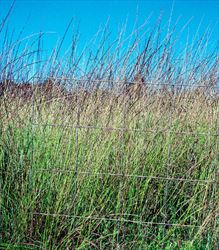
infestation (Photo: Land Protection, QDNRW)
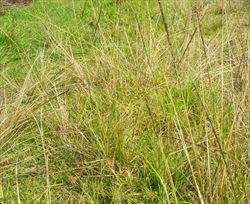
infestation (Photo: Forest and Kim Starr, USGS)

habit (Photo: Forest and Kim Starr, USGS)
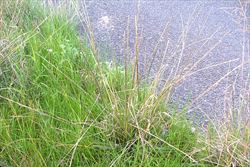
habit (Photo: Sheldon Navie)
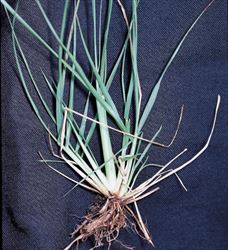
leaves and roots (Photo: Land Protection, QDNRW)

long and narrow seed-head (Photo: Jackie Miles and Max Campbell)

close-up of branches of young seed-head (Photo: Sheldon Navie)

close-up of seed-head in flower (Photo: Jackie Miles and Max Campbell)
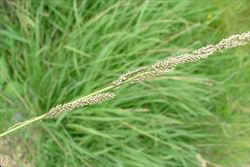
close-up of lower part of seed-head (Photo: Sheldon Navie)
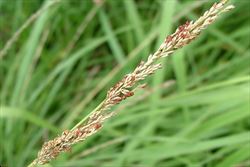
close-up of mature seed-head with seeds (Photo: Sheldon Navie)

close-up of mature flower spikelets and seeds (Photo: Sangita Shrestha)
Scientific Name
Sporobolus fertilis (Steud.) W.D. Clayton
Synonyms
Agrostis fertilis Steud.Sporobolus diandrus (Retz.) P. Beauv. var. major BüseSporobolus indicus (L.) R. Br. var. fertilis (Steud.) Jovet & GuedesSporobolus indicus (L.) R. Br. var. major (Buse) Baaijens
Family
Gramineae (South Australia)Poaceae (Queensland, New South Wales, the ACT, Victoria, Tasmania, Western Australia and the Northern Territory)
Common Names
Australian smutgrass, bloomsbury grass, giant Parramatta grass, smutgrass
Origin
This species is considered to be native to the Indian sub-continent (i.e. India and Sri Lanka), eastern Asia (i.e. China, Japan, Korea, Taiwan, Myanmar, Indonesia, Malaysia, the Phillipines and Papua New Guinea) and some islands in the western Pacific.
Naturalised Distribution
Giant Parramatta grass (Sporobolus fertilis ) is widely distributed in the eastern parts of Australia, and is most common in the coastal regions of Queensland and in eastern New South Wales. It is also naturalised in the ACT, Victoria and the Northern Territory.
It is also present on Christmas Island and the Cocos Islands, though it may be native to these islands.
Habitat
A weed of pastures, roadsides, disturbed sites, waste areas, open woodlands, grasslands, wetlands and parks in tropical, sub-tropical and warmer temperate regions.
Habit
An upright (i.e. erect) and long-lived (i.e. perennial) grass usually growing 70-160 cm tall, but occasionally reaching up to 2 m in height. It forms large tussocks up to 40 cm across.
Distinguishing Features
- an upright and long-lived grass usually growing 70-160 cm tall and forming large tussocks.
- its very long and narrow leaf blades (14-110 cm long and 1.5-5 mm wide) may be flat or somewhat rolled.
- its seed-heads are very thin and elongated in appearance (15-50 cm long and 1-2 cm wide).
- they are spike-like with many short branches held closely to the stem, however the lowest branches may droop slightly open.
- each of these seed-head branches bears numerous tiny flower spikelets (1.5-2 mm long).
Stems and Leaves
The hairless (i.e. glabrous) flowering stems (i.e. culms) are relatively slender (2-5 mm thick), but somewhat wiry, and are usually not branched.
The leaves are very narrow (i.e. linear) with a leaf sheath, which partially encloses the stem, and a spreading leaf blade that may droop towards the ground. The leaf sheaths are hairless (i.e. glabrous), or have some tiny hairs along their margins, and may become separated from the stem as they age. The leaf blades (14-110 cm long and 1.5-5 mm wide) are hairless (i.e. glabrous), may be flat or somewhat rolled (i.e. convolute), and have pointed tips (i.e. acuminate apices). Where the leaf sheath meets the leaf blade their is a fringe of tiny hairs (i.e. ciliated ligule) about 0.2-0.5 mm long.
Flowers and Fruit
The seed-heads are borne at the top of the stems and are very thin and elongated in appearance (15-50 cm long and 0.5-2 cm wide). These spike-like seed-heads (i.e. spiciform panicles) have most of their relatively long branches (2-8 cm long) held closely (i.e. appressed) to the stem, however some of the lowest branches may droop away slightly from the central stalk of the seed-head (i.e. rachis). Each of these branches bears numerous tiny, densely packed, elongated (i.e. lanceolate) or egg-shaped (i.e. ovate), flower spikelets (1.5-2 mm long) almost to its base. The dark green or greyish-green flower spikelets contain a single tiny flower (i.e. floret) inside two bracts (i.e. glumes). The lower bract (i.e. glume) is 0.4-0.7 mm long and the upper bract (i.e. glume) is 0.8-1.3 mm long (i.e. at least half the length of the flower spikelet). Flowering occurs during spring, summer and autumn.
The tiny 'seeds' (i.e. grains or caryopses) are initially whitish in colour, but turn yellowish-brown or reddish-brown as they mature. These seeds (0.8-1.2 mm long and 0.5-0.75 mm wide) are oblong or egg-shaped (i.e. obovoid) and separate from the remainder of the flower spikelet at maturity (i.e. the pale coloured old glumes remain on the seed-head).
Reproduction and Dispersal
This species produces large quantities of tiny seeds. These seeds become somewhat sticky when wet and are often spread by animals and vehicles. They may also be dispersed by water, in mud, and in contaminated agricultural produce (e.g. in fodder and pasture seed lots).
Environmental Impact
Giant Parramatta grass (Sporobolus fertilis) is regarded as an environmental weed Queensland and New South Wales, and was recently listed as a priority environmental weed in at least one Natural Resource Management region.
This species invades native grasslands, open woodlands, conservation reserves and wetland areas and when fully established it excludes native plants. Giant Parramatta grass (Sporobolus fertilis) is one of the exotic perennial grass species whose invadion of native plant communities in New South Wales has been listed as a "key threatening process". It is also ranked among the top 50 environmental weeds in south-eastern Queensland and is thought to pose a significant threat to rangeland biodiversity in central and northern Queensland.
Other Impacts
Giant Parramatta grass (Sporobolus fertilis) is a particularly serious problem in pastures in the wetter areas on the north coast of New South Wales. It is of low palatability and reduces the productivity of agricultural land by completely displacing desirable pasture species. The productivity and carrying capacity of invaded pastures can be significantly reduced, and farmers have reported losses in carrying capacity ranging from 10 to 80% depending on the density of the infestation. Cattle grazing in pastures infested with giant Parramatta grass (Sporobolus fertilis ) also take significantly longer to reach equivalent weights to those grazing in uninfested pastures, and the tough fibrous nature of the stems can also increase teeth wear in livestock.
Giant Parramatta grass (Sporobolus fertilis) can have other less obvious impacts, such as causing damage to asphalt on roadsides and tracks and decreasing the aesthetic appeal of infested areas. Large infestations may also affect fire intensity and/or frequency, particularly in winter and spring.
Legislation
This species is declared under legislation in the following states and territories:
- New South Wales: Class 3 - a regionally controlled weed. The relevant local control authority must be promptly notified of the presence of this weed and it must be fully and continuously suppressed and destroyed (in a large number of local authority areas), and Class 4 - a locally controlled weed. The growth and spread of this species must be controlled according to the measures specified in a management plan published by the local control authority and the plant may not be sold, propagated or knowingly distributed (in a minority of local authority areas). See the New South Wales Department of Primary Industries Noxious Weeds List at http://www.dpi.nsw.gov.au for more detailed information on which local areas are covered in these declarations.
- Queensland: Class 2 - landowners must take all reasonable steps to keep land free of this species (throughout the entire state). It is also illegal to sell a declared plant or its seed in this state.
- Western Australia: Unassessed - this species is declared in other states or territories and is prohibited until assessed via a weed risk assessment (throughout the entire state).
Management
For information on the management of this species see the following resources:
- the Biosecurity Queensland Fact Sheet on giant rats tail grass and other weedy Sporobolus species, which is available online at http://www.dpi.qld.gov.au.
- the New South Wales Department of Primary Industries Agfact on this species, which is available online at http://www.bellingerlandcare.org.au
Similar Species
Giant Parramatta grass (Sporobolus fertilis) is very similar to other introduced rats-tail grasses (Sporobolus spp.), including Parramatta grass (Sporobolus africanus), American rats-tail grass (Sporobolus jacquemontii), and the giant rats-tail grasses (Sporobolus pyramidalis and Sporobolus natalensis). It is also similar to some native species such as the slender rats-tail grasses (Sporobolus creber and Sporobolus elongatus). Distinguishing between these species is often very difficult and a specialist may need to be consulted, however the following is a guide to the differences that may be apparent:
- giant Parramatta grass (Sporobolus fertilis) is a relatively large plant (usually 80-160 cm tall) with relatively large spike-like (i.e. spiciform) seed-heads (15-50 cm long). These seed-heads have numerous moderately long branches (20-80 mm long) that are held closely (i.e. appressed) to the main stem or slightly spreading. These branches are normally densely arranged and the seed-head is mostly un-interrupted (except occasionally at the base). Its flower spikelets are relatively small (1.5-2 mm long).
- Parramatta grass (Sporobolus africanus) is a relatively small plant (usually less than 50 cm tall) with relatively small spike-like (i.e. spiciform) seed-heads (6-35 cm long). These seed-heads have numerous short branches (10-20 mm long) that are usually held closely (i.e. appressed) to the main stem. These branches are normally densely arranged and the seed-head is mostly un-interrupted (except occasionally at the base). Its flower spikelets are relatively large (2-2.8 mm long).
- American rats-tail grass (Sporobolus jacquemontii) is a moderately-sized plant (usually 50-75 cm tall) with relatively small elongated seed-heads (8-25 cm long). These seed-heads have numerous relatively long branches (50-100 mm long) that usually spread away from the main stem. These branches are normally densely arranged and the seed-head is un-interrupted. Its flower spikelets are relatively small (1.5-2 mm long).
- giant rats-tail grass (Sporobolus pyramidalis) is a relatively large plant (usually 90-200 cm tall) with relatively large pyramid-shaped (i.e. pyramidal) seed-heads (20-45 cm long). These seed-heads have numerous relatively long branches (50-100 mm long) that stiffly spread away from the main stem. Its flower spikelets are moderately-sized (1.7-2.2 mm long).
- giant rats-tail grass (Sporobolus natalensis) is a relatively large plant (60-150 cm tall) with relatively large spike-like (i.e. spiciform) seed-heads (20-30 cm long). These seed-heads have numerous relatively long branches (30-70 mm long) that usually spread away from the main stem. These branches are normally densely arranged and the seed-head is un-interrupted. Its flower spikelets are moderately-sized (1.6-2.3 mm long).
- slender rats-tail grass (Sporobolus creber) is a moderately-sized plant (usually less than 100 cm tall) with relatively long and very narrow spike-like (i.e. spiciform) seed-heads (18-60 cm long). These seed-heads have numerous short stiff branches (5-10 mm long) that are always held closely (i.e. appressed) to the main stem. These branches are normally widely spaced and the seed-head is interrupted (except near the top). Its flower spikelets are relatively small (1.2-1.7 mm long).
- slender rats-tail grass (Sporobolus elongatus) is a moderately-sized plant (usually 50-100 cm tall) with relatively long and narrow spike-like (i.e. spiciform) seed-heads (10-30 cm long). These seed-heads have numerous relatively long branches (40-80 mm long) that are usually held closely (i.e. appressed) to the main stem (sometimes slightly spreading). These branches are normally densely arranged and the seed-head is mostly un-interrupted (except occasionally at the base). Its flower spikelets are moderately-sized (1.5-2.3 mm long).

